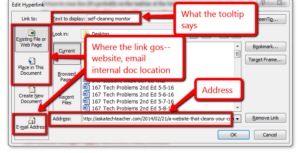A Book New–and Veteran–Teachers Will Want to Read
They Call Me Mom

- How did i get here
- Setting up your classroom
- Working with students
- Working with colleagues
- Working with your boss
- Discipline
“Instead of saying, “Do everything my way, and you can become a successful teacher,” she was giving me her permission to find my way.”
“…storytelling was one of the most successful methods to get my students to pay attention.”
Share this:
- Click to share on Facebook (Opens in new window) Facebook
- Click to share on X (Opens in new window) X
- Click to share on LinkedIn (Opens in new window) LinkedIn
- Click to share on Pinterest (Opens in new window) Pinterest
- Click to share on Telegram (Opens in new window) Telegram
- Click to email a link to a friend (Opens in new window) Email
- More
SEL in Your Classroom
SmartBrief, news on technology in education, recently published an article, Uniting technology and SEL to teach the whole child, on the importance of SEL (Social-Emotional Learning) in an educational landscape shaped by COVID-19. In part, they shared:
Social-emotional learning is seeing a surge in mentions in the educational landscape. Most recently, the COVID-19 pandemic clearly illuminated the fact that academic growth and social and emotional wellness are interdependent and that educators must take into account the social and emotional aspects of a student’s reality as they consider academic development.
I know firsthand the power of SEL, both as a teacher and as a former student. I was born and raised in the rural mountains of North Carolina and was greatly influenced by a teacher who led with compassion. This educator forever changed my life because she saw “the whole child” — she recognized me as more than my abilities in reading and math. She saw me as a hurt child from a broken home, although it was the only home I knew, and knew she could help me reach my potential by engaging me on a social and emotional level.
For more background on SEL, check out our article discussing “The Importance of SEL to Education Success“:
Life is much simpler when you — as a parent or teacher — can point to one solution for a problem, solve it, and everything is golden. Success in school was like that when grades were the barometer and studying harder was the tool. Now, we know academic achievement is much more complicated.
“Students are telling us there’s a big missing piece in their education” –John Bridgeland, CEO of Civic
Today’s educators realize learning has as much to do with academics as how students get along with themselves and others. This is called “Social Emotional Learning” or SEL. It’s akin to the importance of play in teaching preschool kids to socialize with others, develop tenacity, and learn respect for those around them. If you’re not convinced of the importance of SEL, here’s what students say:
“Students and young adults believe SEL schools would create a more positive social and learning environment” — report by the Collaboration for Academic, Social and Emotional Learning (CASEL)
A positive attitude about themselves and others is linked to not only academic success but correlated to lessening the negative impact of future-ending problems such as drug use. It should surprise no one that as of mid-2018, two states have passed SEL measures, sixteen SEL-related bills and resolutions have been introduced, and twenty-three states are working on SEL standards.
-
- What is SEL
- Why teach SEL in schools
- SEL exercises
- SEL resources
- Vocabulary
- More
Share this:
- Click to share on Facebook (Opens in new window) Facebook
- Click to share on X (Opens in new window) X
- Click to share on LinkedIn (Opens in new window) LinkedIn
- Click to share on Pinterest (Opens in new window) Pinterest
- Click to share on Telegram (Opens in new window) Telegram
- Click to email a link to a friend (Opens in new window) Email
- More
Tech Tip #3: Turn an Address into a Link
 In these 169 tech-centric situations, you get an overview of pedagogy—the tech topics most important to your teaching—as well as practical strategies to address most classroom tech situations, how to scaffold these to learning, and where they provide the subtext to daily tech-infused education.
In these 169 tech-centric situations, you get an overview of pedagogy—the tech topics most important to your teaching—as well as practical strategies to address most classroom tech situations, how to scaffold these to learning, and where they provide the subtext to daily tech-infused education.
Today’s tip: Turn an Address into a Link
Category: MS Office, Google Apps, internet, Edit/Format
Q: I get documents from friends with links to websites. How do they do that?
 A: When you want to send a website address to people, here’s what you do:
A: When you want to send a website address to people, here’s what you do:
- Copy the address located at the top of the screen (right click on it and select copy).
- Return to your doc (it’s probably on the taskbar at the bottom of your screen) and paste the address into the message (using right-click>paste, edit>paste, or the paste tool on the top toolbar).
- Push the space bar once or push enter after the address. That activates the link. You’ll know you succeeded because it turns blue with an underline.
If you want to paste a link behind words:
- Highlight the text you want the website linked to
- Ctrl+K to bring up the link dialogue box
- Ctrl+V to paste your link
- Push enter for ‘OK’
This works in MS Office, Google Apps, and lots of online webtools.
Sign up for a new tip each week or buy the entire 169 Real-world Ways to Put Tech into Your Classroom.
What’s your favorite tech tip in your classroom? Share it in the comments below.
Share this:
- Click to share on Facebook (Opens in new window) Facebook
- Click to share on X (Opens in new window) X
- Click to share on LinkedIn (Opens in new window) LinkedIn
- Click to share on Pinterest (Opens in new window) Pinterest
- Click to share on Telegram (Opens in new window) Telegram
- Click to email a link to a friend (Opens in new window) Email
- More
16+ Websites on Assessments
Here are a few of the popular resources teachers are using to
- Blendspace–if you create your lesson plans in BlendSpace, it includes opportunities to assess learning
- Easy CBM
- Educreations–video a whiteboard explanation of how students are completing a task (app)
- Edulastic–formative assessments; work on any devices (app)
- Flip — record a video question from your desktop; add attachments; students respond from the app with their answer and decorations; appears as a grid of answers to the question (app)
- Flubaroo (app)
- Gimkit–gamified assessment, like Kahoot; freemium
- Go Formative (app)
- Google Forms (app)
- Kahoot–quiz-show-like format (app)
- Nearpod–works on iOS and the web; free or fee; plan lessons and then assess; send an image and have students draw on the screen with their answers (app)
- QR Stuff–send almost any type of file to a QR code–includes YouTube videos and audio files (create the QR online and scan with an app) (app)
- Recap–create an account, sign students up, they log in and you’re ready for formative assessments (app)
- Socrative (app)
- Stick Around–turn questions into puzzles (app)
- ThatQuiz.org
Click here for more
Click here for updates to this list.
Share this:
- Click to share on Facebook (Opens in new window) Facebook
- Click to share on X (Opens in new window) X
- Click to share on LinkedIn (Opens in new window) LinkedIn
- Click to share on Pinterest (Opens in new window) Pinterest
- Click to share on Telegram (Opens in new window) Telegram
- Click to email a link to a friend (Opens in new window) Email
- More
Technology and Teaching: A Conversation with Teachers
Ask a Tech Teacher contributor, Christian Miraglia, taught for 36 years before retiring. Here is Part 2 of his discussion on technology’s place in education:
Part II Technology is Here to Stay: A Conversation with Teachers
 In my previous post, I wrote about the permanency of technology in the instructional setting for educators. Over the past weeks, I have spoken to a few educators about what has changed for them in this area. There is no doubt that the use of tech tools beyond the general record-keeping for attendance and grading has now found a footing in most classrooms around the nation. Some teachers who were initially hesitant to jump into the depths of technology integration find themselves fully immersed. Some who were on the proverbial edge of the diving board have been pushed into the pool and some have embraced the change with the excitement of a child playing with a new toy.
In my previous post, I wrote about the permanency of technology in the instructional setting for educators. Over the past weeks, I have spoken to a few educators about what has changed for them in this area. There is no doubt that the use of tech tools beyond the general record-keeping for attendance and grading has now found a footing in most classrooms around the nation. Some teachers who were initially hesitant to jump into the depths of technology integration find themselves fully immersed. Some who were on the proverbial edge of the diving board have been pushed into the pool and some have embraced the change with the excitement of a child playing with a new toy.
I recently spoke with a fellow history teacher who has embraced the technology and been quite creative in the process. With a focus on the social-emotional component of instruction, he utilized a master Google Slide deck coupled with one of the Eduprotocols skills such as Number Mania or Iron Chef and the content he was covering. This procedure allowed him to see all of his students responding to the prompt and kept him connected to the students throughout the year. Taking the learning to another level as well as incorporating the 21st Century skill of communication, his students showed their parents an exhibit using Flipgrid they had built based on the unit essential question. Without the use of this recording tool, the work would have been relegated to the school’s LMS as a click-through for the teacher. Moreover, with the exhibit being published, the student’s parents now had validation of their child’s work. Very powerful indeed.
Another teacher found that utilizing an IDE (Integrated Development Environment) that was cloud-based gave her students round-the-clock access to work in their programming class instead of relying on a downloaded file to a school computer. In our current environment, this addresses the issue of student access to content extending beyond the limitations to work only done in between walls of the classrooms.
In another conversation with a colleague of mine who is also a history teacher at the high school level, it was pointed out that because students were just glad to be back in a classroom setting they embraced any assignment that he pushed out. Because of the social distancing mandate in his district, it was important that he be strategic in his instructional strategy. In the previous year of pandemic instruction, he explored how discussion panels could be used specifically using Canvas. He found that students were inclined to post well-thought responses as they looked forward to the feedback from their peers. The same collaborative approach was taken once students returned back to school in the summer utilizing the Eduprotocols. Once school started a couple of weeks ago with limitations on classroom movement students were able to collaborate on Google slides and communicate with each other by using the same strategy. More importantly, after students collaborated they had to report out on their choices. The selection of the strategy and technology tool was very intentional to create a more engaging environment as well as providing for a platform for the students learning experience.
Share this:
- Click to share on Facebook (Opens in new window) Facebook
- Click to share on X (Opens in new window) X
- Click to share on LinkedIn (Opens in new window) LinkedIn
- Click to share on Pinterest (Opens in new window) Pinterest
- Click to share on Telegram (Opens in new window) Telegram
- Click to email a link to a friend (Opens in new window) Email
- More
16 Websites and 5 Posters to Teach Mouse Skills
 Many of my most popular articles are about mouse skills. Every year, tens of thousands of teachers visit Ask a Tech Teacher to find resources for teaching students how to use a mouse. No surprise because using a mouse correctly is one of the most important pre-keyboarding skills. Holding it is not intuitive and if learned wrong, becomes a habit that’s difficult to break.
Many of my most popular articles are about mouse skills. Every year, tens of thousands of teachers visit Ask a Tech Teacher to find resources for teaching students how to use a mouse. No surprise because using a mouse correctly is one of the most important pre-keyboarding skills. Holding it is not intuitive and if learned wrong, becomes a habit that’s difficult to break.
The earlier posts are still active, but I’ve updated this resource with more websites and posters to assist in starting off your newest computer aficionados. Check here for updates on links.
Mouse Skills
- MiniMouse
- Mouse and tech basics–video
- Mouse practice—drag, click
- Mouse skills
- Mouse Song
-
OwlieBoo–mouse practice
- Wack-a-gopher (no gophers hurt in this)
Puzzles
- Digipuzzles–great puzzles for geography, nature, and holidays
- Jigsaw Planet–create your own picture jigsaw
- Jigsaw puzzles
- Jigsaw Puzzles–JS
Adults
Trackpad
Many of these are simply repurposing mouse skill sites to the trackpad.
Posters
Share this:
- Click to share on Facebook (Opens in new window) Facebook
- Click to share on X (Opens in new window) X
- Click to share on LinkedIn (Opens in new window) LinkedIn
- Click to share on Pinterest (Opens in new window) Pinterest
- Click to share on Telegram (Opens in new window) Telegram
- Click to email a link to a friend (Opens in new window) Email
- More
Does Mindfulness Make Your Class Better?
District Administration recently published an interesting article on how mindfulness creates kinder classrooms and reduces problematic behaviors by 18%. Click the link and check out their thoughts.
If you’d like background on Mindfulness, check our article published earlier on
How to Incorporate Mindfulness into Your Class
Students learn best when they are relaxed, happy, and feeling loved. It is challenging to include those characteristics in classes when you are concurrently trying to achieve school goals, comply with curriculum timelines, juggle parent concerns, and blend your lessons with those of colleagues.
This is where mindfulness becomes important. It reminds teachers that the fulcrum for learning is the student’s emotional well-being.
Let’s back up a moment: What is mindfulness? Buddha said:
“Do not dwell in the past, do not dream of the future, concentrate the mind on the present moment.”
If that’s the plan, mindfulness is the path. It teaches students how to quiet themselves — get to a place where their mind is settled sufficiently to pay full attention to the task at hand. Experts offer many suggestions for incorporating mindfulness into your classroom experience. Consider:
- pause and take a deep breath before beginning an activity or in the middle of performing it
- reflect on an activity as a group
- reflect on the student’s own experiences and background and how that relates to the topic
Delving into these rudimentary steps isn’t the goal of this article. Today, I’ll share five ideas on taking mindfulness to the next level in your classes:
Share this:
- Click to share on Facebook (Opens in new window) Facebook
- Click to share on X (Opens in new window) X
- Click to share on LinkedIn (Opens in new window) LinkedIn
- Click to share on Pinterest (Opens in new window) Pinterest
- Click to share on Telegram (Opens in new window) Telegram
- Click to email a link to a friend (Opens in new window) Email
- More
9/11… We Remember
America, we love you.
[youtube=http://www.youtube.com/watch?v=6TPgJSZf5Vw&w=420&h=315]Share this:
- Click to share on Facebook (Opens in new window) Facebook
- Click to share on X (Opens in new window) X
- Click to share on LinkedIn (Opens in new window) LinkedIn
- Click to share on Pinterest (Opens in new window) Pinterest
- Click to share on Telegram (Opens in new window) Telegram
- Click to email a link to a friend (Opens in new window) Email
- More
Creative Options for Remote Learning
With schools closed for in-person learning and many children being educated at home, parents are scrambling for quality alternatives that work in a home environment. One of our Ask a Tech Teacher contributors has some ideas you may not have thought of:
How to Make Remote Learning Work For Your Children
 Many parents are choosing to opt-out of traditional schooling, but the question of how to create a well-rounded curriculum or who to hire for this task is often the barrier that prevents at-home learning. In this article, we’ll help you make a decision by presenting popular remote learning options or childcare resources that can support homeschooling or non-traditional approaches.
Many parents are choosing to opt-out of traditional schooling, but the question of how to create a well-rounded curriculum or who to hire for this task is often the barrier that prevents at-home learning. In this article, we’ll help you make a decision by presenting popular remote learning options or childcare resources that can support homeschooling or non-traditional approaches.
Traditional Homeschooling
Homeschooling is a progressive movement where parents educate their children instead of sending them to public or private schools. Families will choose this option for various reasons, including dissatisfaction with public education, constant relocation, or a bad social environment.
Some of the many positives of homeschooling your children include:
- Home-educated children score 15 to 30 percentile points higher than other students.
- Homeschooled children get accepted by colleges at a higher rate than other students.
- Homeschool helps children develop better social skills than their public school peers.
- Special needs children receive a significantly higher level of education on average.
- Adults who were homeschooled are more politically tolerant and happier on average.
Homeschooling is legal in all 50 states, but the legal requirements for this education option vary from place to place. If you’re in the process of pulling your children out of public education, you’ll need to write a letter of withdrawal to the school board that describes your intent to homeschool.
There are many curriculum options available for parents. As long as your curriculum of choice follows the requirements of your state, they can apply for college once they graduate. Parents don’t need a formal teaching degree to qualify as homeschool teachers. It may be beneficial for you to take an online course that goes over teaching fundamentals and how to run a classroom.
Share this:
- Click to share on Facebook (Opens in new window) Facebook
- Click to share on X (Opens in new window) X
- Click to share on LinkedIn (Opens in new window) LinkedIn
- Click to share on Pinterest (Opens in new window) Pinterest
- Click to share on Telegram (Opens in new window) Telegram
- Click to email a link to a friend (Opens in new window) Email
- More
19 Ed Websites to Fill Spare Classroom Time
I keep a list of themed websites that are easy-in easy-out for students. They must be activities that can be accomplished enjoyably in less than ten minutes. In the parlance, these are called “sponges”. Here are 19 I think you’ll like:
Language Arts
- Contraction Games
- Contraction Crossword
- Contraction Practice
- Feast of Homonyms
- Grammar Gorillas
- Grammaropolis
- Plural Nouns
- Suffix Match
Math
Problem solving
- The Crossing–attempts to cross a gorge; some fail; all result in success
- Math Pickle–put student in a choatic situation and see how they solve the problem
Science
Share this:
- Click to share on Facebook (Opens in new window) Facebook
- Click to share on X (Opens in new window) X
- Click to share on LinkedIn (Opens in new window) LinkedIn
- Click to share on Pinterest (Opens in new window) Pinterest
- Click to share on Telegram (Opens in new window) Telegram
- Click to email a link to a friend (Opens in new window) Email
- More













































